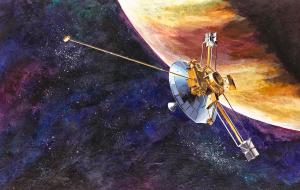Post
Ten Billionths
of a Gee
22 July 2013
 NASA
NASAPioneer 10 was launched in 1972. The next year Pioneer 11 was launched. Their mission was to fly past Jupiter and then Saturn, making the first detailed studies of the planets. Afterwards, they continued their journey to the outer reaches of the solar system. At this point they entered a second phase of their mission, to study the diffuse gases in the solar system on their way to interstellar space. Their observations indicated that something rather strange was going on.
The Pioneer spacecraft gradually slow down as they speed away from the Sun. Most of this is due to the Sun’s gravity, but part is due to the drag of the gases that exist in the solar system. When all the factors were taken into account, it was found that the Pioneer probes were slowing down a bit faster than expected. This extra deceleration was tiny, amounting to about a ten billionth of a gee (Earth’s surface gravity). This tiny discrepancy became known as the Pioneer anomaly.
The Pioneer probes were the first missions to travel beyond the planets, so in many ways it was the first direct experimental test of our understanding of gravity at stellar distances. It was possible, then, that the Pioneer anomaly was due to some deviation from the gravitational models of Newton and Einstein. Perhaps something such as modified Newtonian dynamics (MOND) was coming into play. Perhaps they were experiencing the effects of dark matter. Interestingly, the Pioneer acceleration was roughly equal in magnitude to the speed of light times the Hubble constant, which suggested some type of cosmic connection.
But there were several problems with these ideas. Most significantly, the orbital motions of the planets agreed with Newton and Einstein perfectly. If the effect was due to dark matter, or a similar modified gravity model, then the planets should be affected as well. That they weren’t was a serious problem. So modified inertia models were proposed, as were more mundane ideas such as gas leaks from the probes themselves, or even simply systematic errors in the measurement of their motion.
A proven solution wasn’t found until 2012, and the answer happened to be rather mundane.1 The power source of each probe was a radioisotope thermoelectric generator (RTG), which uses heat produced by radioactive decay to generate electricity. Since RTGs generate heat, and are in the cold vacuum of space, they radiate heat as infrared light. When light is emitted it has a very small amount of momentum, which means the object emitting the light would recoil slightly in the opposite direction. This effect is known as thermal recoil.
Most objects radiate heat uniformly in all directions, so the thermal recoil is negligible. But the design of the Pioneer probes meant that some of the radiated light reflected off the side of the probe facing away from the Sun, which gave the probe a slight deceleration. This produced a thermal recoil that explained the anomaly perfectly.
Now you might think this solution should have been thought of years ago. After all, it seems rather obvious that thermal recoil would play a role for a warm object in the cold of space. In fact the idea was proposed early on, but proving it could account for all of the anomaly was very difficult. We needed to have very precise measurements of the anomaly itself, as well as accurate data on just how the RTGs were cooling over time. It took detailed computer modeling to confirm that thermal recoil could in fact account for the entire anomaly.
There are a few researchers who still explore alternative mechanisms for the Pioneer anomaly, but the thermal recoil explanation has now been confirmed by multiple studies, so the anomaly is generally considered a solved mystery.
Which just goes to show that sometimes new and interesting data doesn’t lead to new and interesting physics.
Turyshev, Slava G., et al. “Support for the thermal origin of the Pioneer anomaly.” Physical review letters 108.24 (2012): 241101. ↩︎